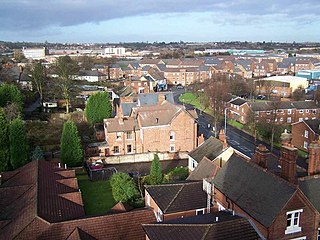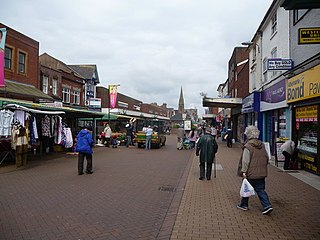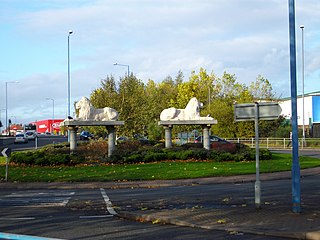
West Bromwich, commonly known as West Brom, is a market town in the borough of Sandwell, in the county of the West Midlands, England. Historically part of Staffordshire, it is 7 miles northwest of Birmingham. West Bromwich is part of the area known as the Black Country, in terms of geography, cultures and dialect. West Bromwich had a population of 103,112 in the 2021 Census.

Tipton is an industrial town in the metropolitan borough of Sandwell, in the county of the West Midlands, England. It had a population of 38,777 at the 2011 UK Census. It is located northwest of Birmingham and southeast of Wolverhampton. It is also contiguous with nearby towns of Darlaston, Dudley, Wednesbury and Bilston.

Wednesbury is a market town in the Sandwell district, in the county of the West Midlands, England - historically in Staffordshire. It is located near the source of the River Tame, and is part of the Black Country. Wednesbury is situated 5 miles (8km) south-east of Wolverhampton, 3 miles (4.4km) south-west of Walsall, and 7 miles (11.8km) north-west of Birmingham. At the 2021 Census, the town's built-up area had a population of 20,313.

Sandwell is a metropolitan borough of the West Midlands county in England. The borough is named after the Sandwell Priory, and spans a densely populated part of the West Midlands conurbation. Sandwell Metropolitan Borough Council defines the borough as the six amalgamated towns of Oldbury, Rowley Regis, Smethwick, Tipton, Wednesbury and West Bromwich. Rowley Regis includes the towns of Blackheath and Cradley Heath.

Bilston is a market town in the City of Wolverhampton in the West Midlands, England. It is in the Black Country, 2.5 miles south east of Wolverhampton city centre and close to the borders of Sandwell and Walsall. The town was known for enamalling from the mid-17th century, and is a former coal and iron mining district. Iron works dominated in Victorian times and the area became a centre for steel production. The town had a population of 34,639 at the 2021 Census.
The West Midlands region straddles the historic borders between the counties of Warwickshire, Staffordshire in the north, and Worcestershire in the south.

Coseley is a village in the Dudley district, in the county of the West Midlands, England. It is situated three miles north of Dudley itself, on the border with Wolverhampton and Sandwell. It falls within the Tipton and Wednesbury parliamentary constituency.

Bradley is a suburban village in the City of Wolverhampton, West Midlands County, England. It is located in the Bilston East ward.

West Bromwich West was a constituency in the West Midlands in the House of Commons of the UK Parliament. It was represented from 1974 until 2019 by members of the Labour Party, and by the Conservatives from 2019 until 2024.

Great Bridge is a historic village and district of Tipton in the Metropolitan Borough of Sandwell in the metropolitan county of the West Midlands, England. It is situated near the towns of Dudley, West Bromwich and Wednesbury.

Tipton Green is the central area of Tipton, a town in the West Midlands of England. It was heavily developed for heavy industry and housing during the 19th century, as Tipton was one of the most significant towns during the Industrial Revolution. Tipton Green is one of three electoral wards covering Tipton for Sandwell Metropolitan Borough Council. The population of this Sandwell ward taken at the 2011 census was 12,834. It is represented by three Labour councillors.

Ocker Hill is a residential area straddling the border of Tipton and Wednesbury in the West Midlands of England.
Hateley Heath is a residential area of West Bromwich, West Midlands.The population of the Sandwell ward taken at the 2011 census was 14,227.

The Birmingham Snow Hill to Wolverhampton Low Level Line was part of the Great Western Railway's London Paddington to Birkenhead Woodside route. As the name suggests, it ran between Birmingham Snow Hill and Wolverhampton Low Level in England. The line was dual-gauged, both 7 ft 1⁄4 in and 4 ft 8+1⁄2 instandard gauge.
The BCN Main Line, or Birmingham Canal Navigations Main Line is the evolving route of the Birmingham Canal between Birmingham and Wolverhampton in England.

The Wednesbury Oak Loop, sometimes known as the Bradley Arm, is a canal in the West Midlands, England. It is part of the Birmingham Canal Navigations (BCN), and was originally part of James Brindley's main line, but became a loop when Thomas Telford's improvements of the 1830s bypassed it by the construction of the Coseley Tunnel. The south-eastern end of the loop was closed and in parts built over, following the designation of the entire loop as "abandoned" in 1954, including the section which was filled in at the beginning of the 1960s to make way for the Glebefields Estate in Tipton.

Tipton and Wednesbury is a constituency of the House of Commons in the UK Parliament. Further to the completion of the 2023 Periodic Review of Westminster constituencies, it was first contested at the 2024 general election. It is represented by Antonia Bance of the Labour Party.














